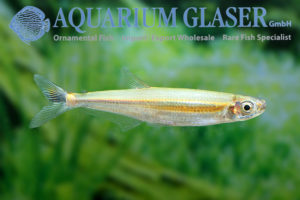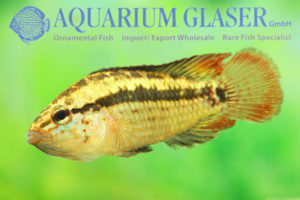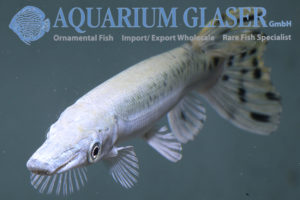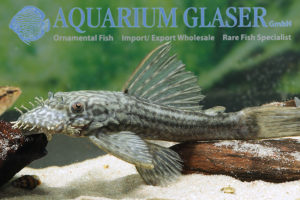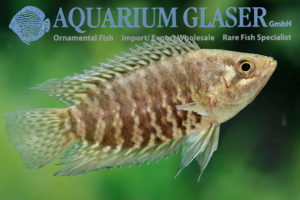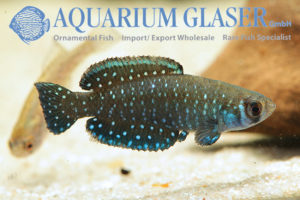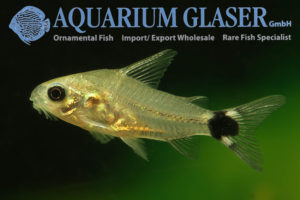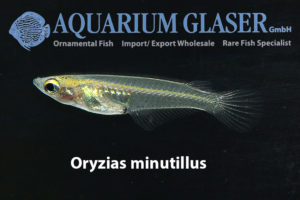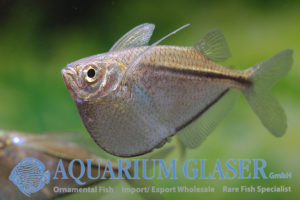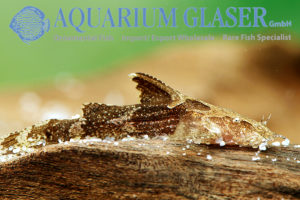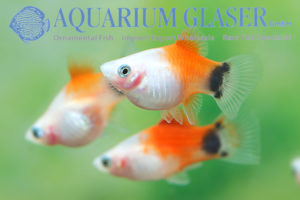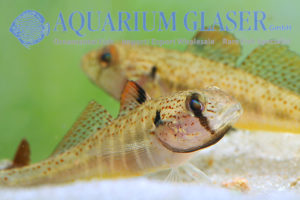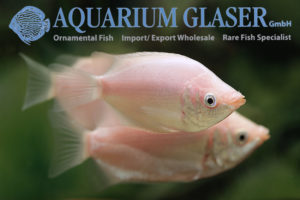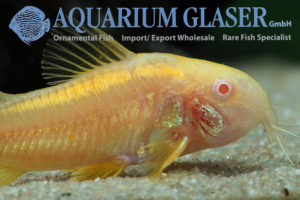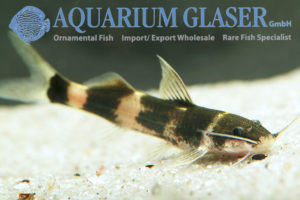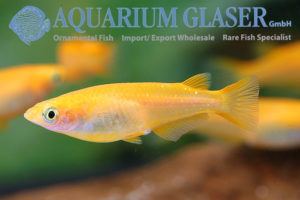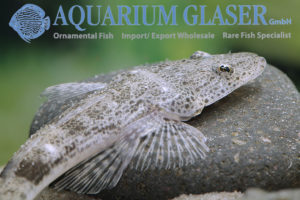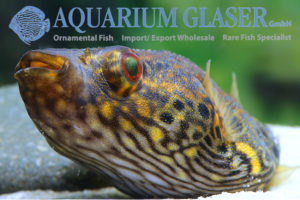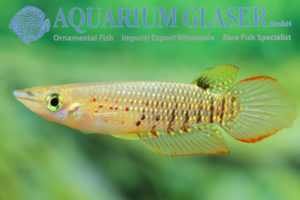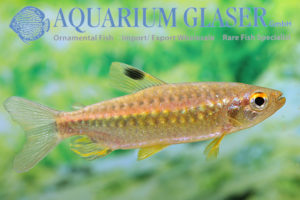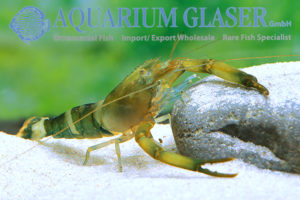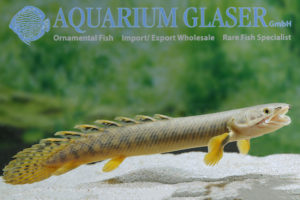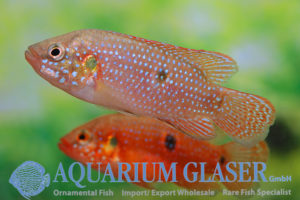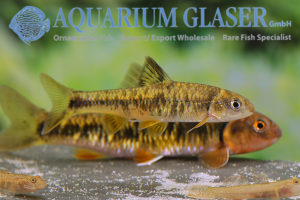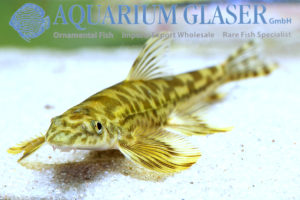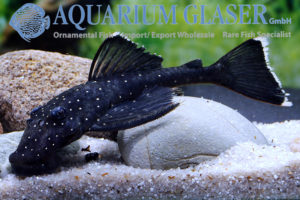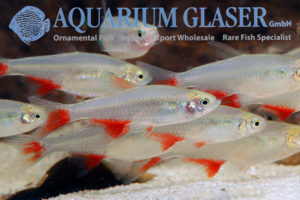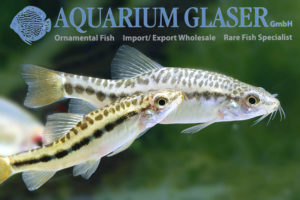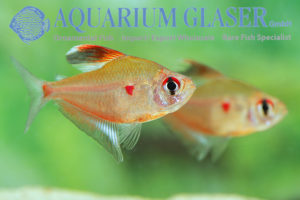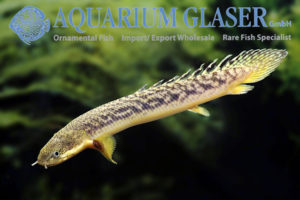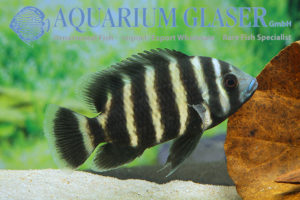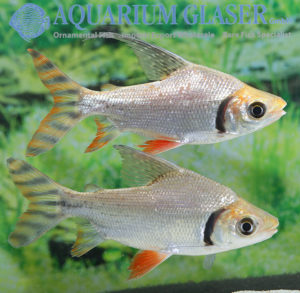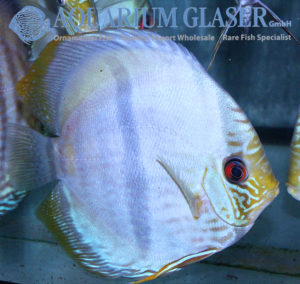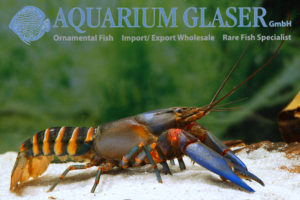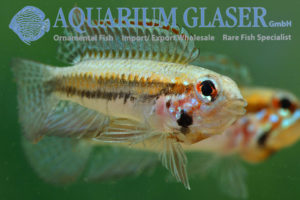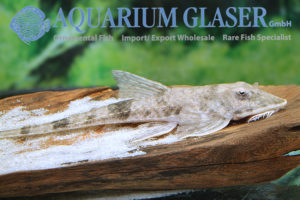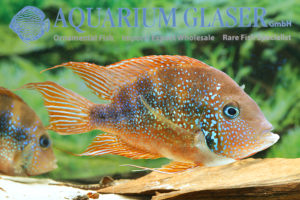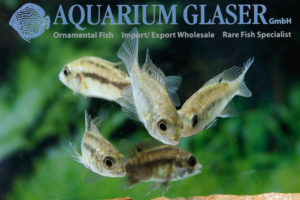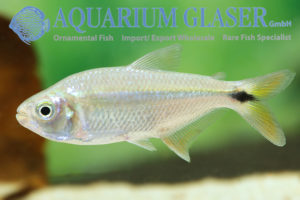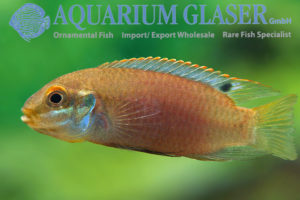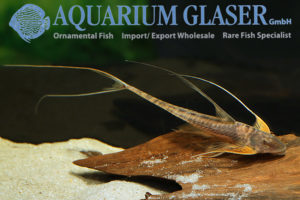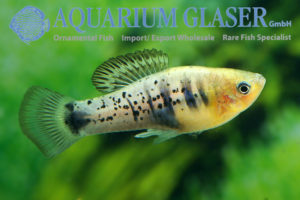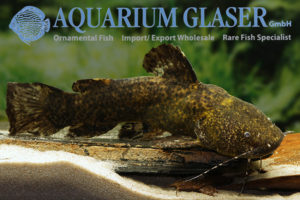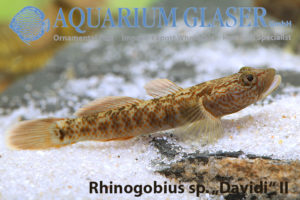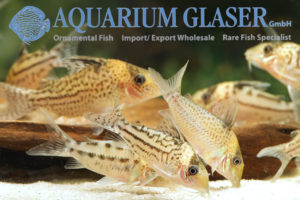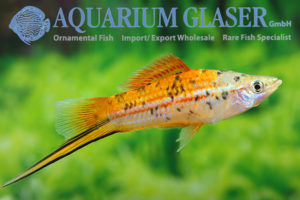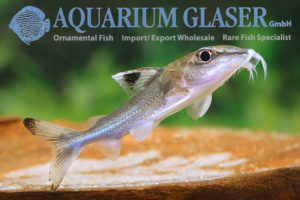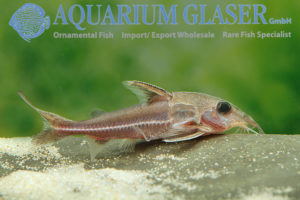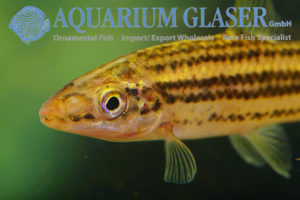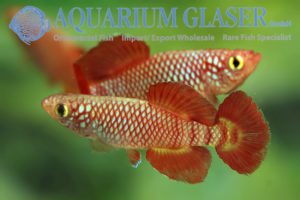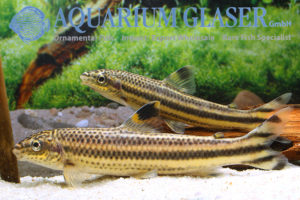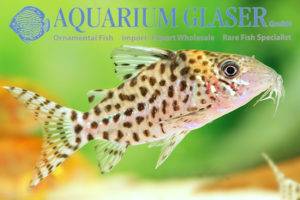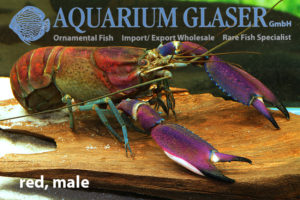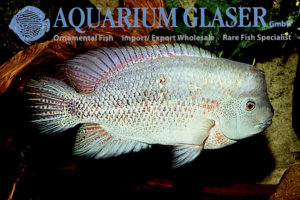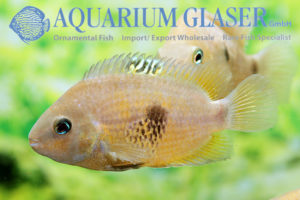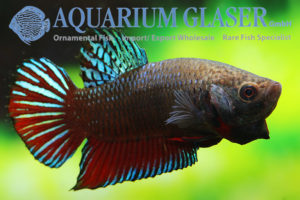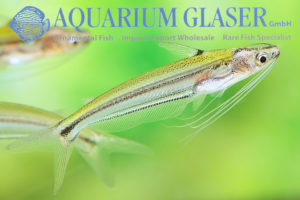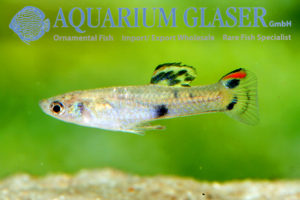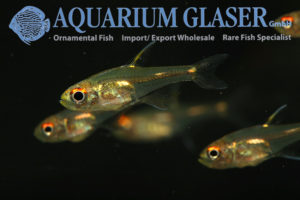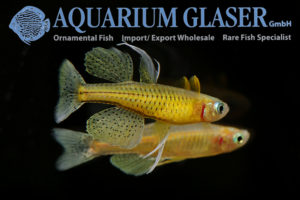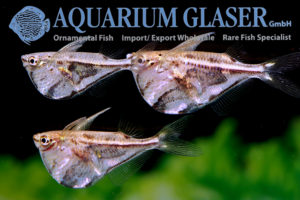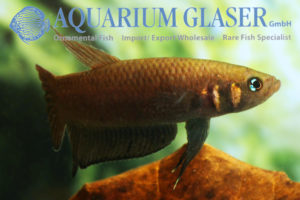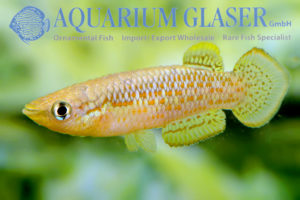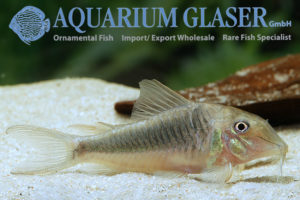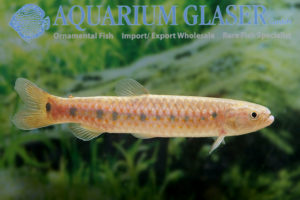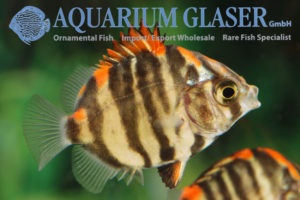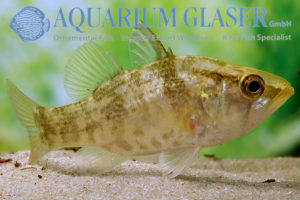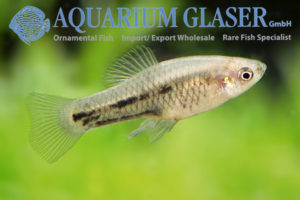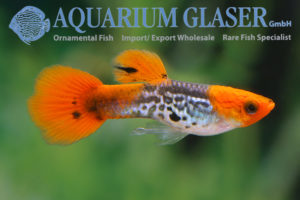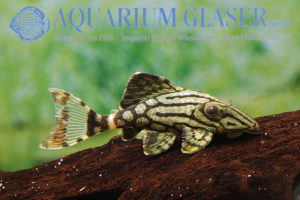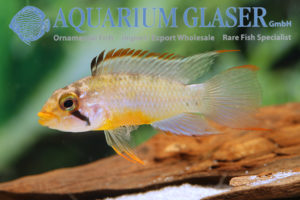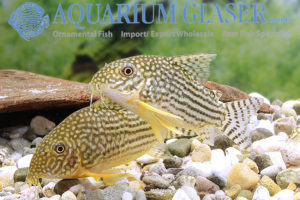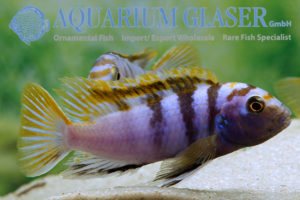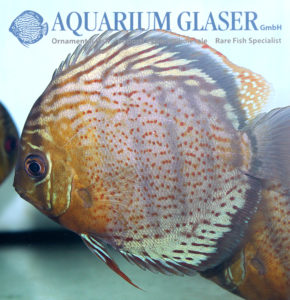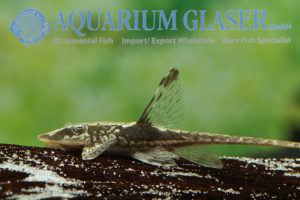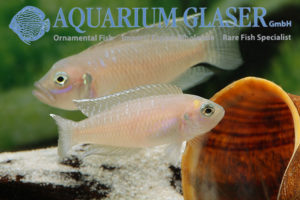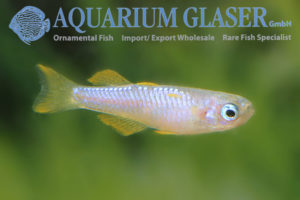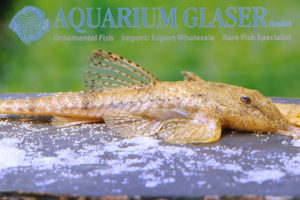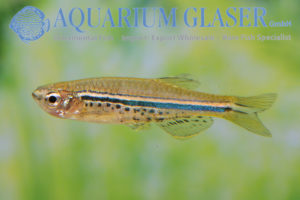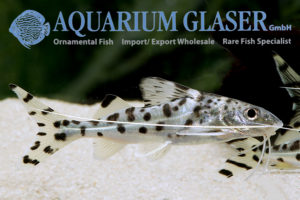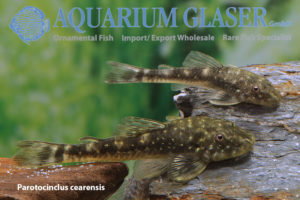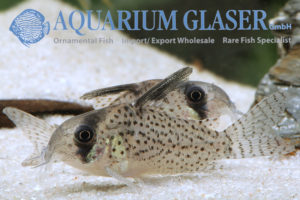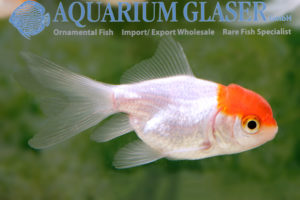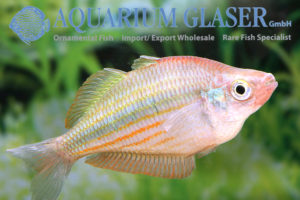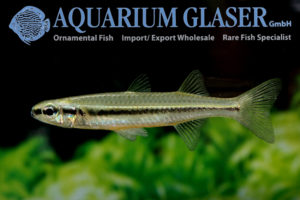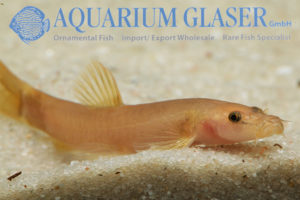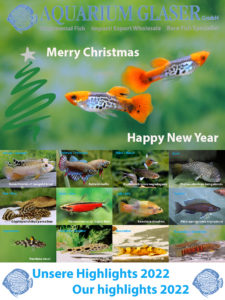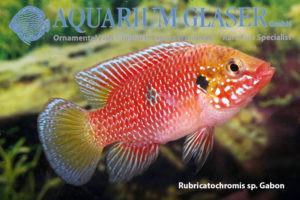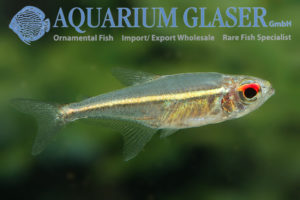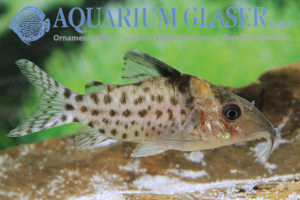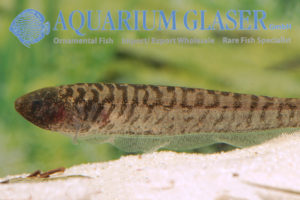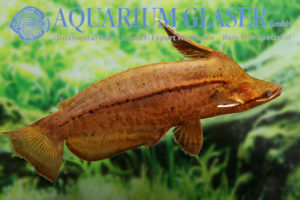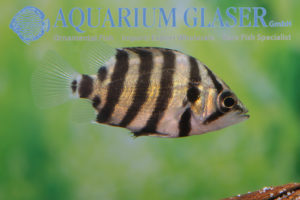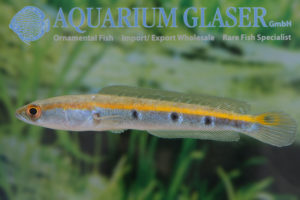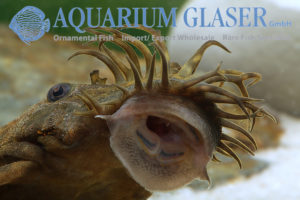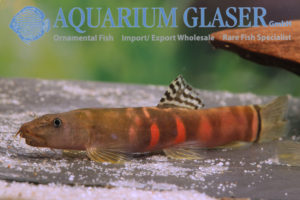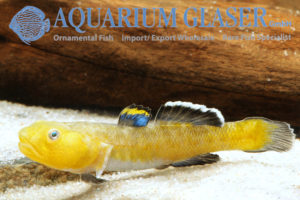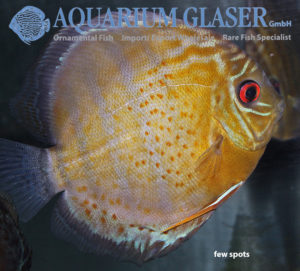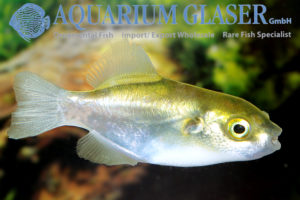From Colombia we received Iguanodectes spilurus. This brings the number of Iguanodectes species imported by us in recent times to four: the red-striped I. geisleri and I. adujai, the three-striped I. purusii and now the golden-striped I. spilurus. The lizard bite tetras (Iguanodectidae) are a peculiar family of South American tetras that got their scientific […]
Fish Archive (2963)
-
-
Apistogramma kullanderi
The “Giant Apistogramma” caused a flurry of excitement when it was discovered in 2009 during an expedition to the Serra do Cachimbo (Pará, Brazil). The discoverers, J. L. O. Birindelli and M. Sabaj Perez, reported on this great fish in various journals, initially under the name A. sp. “Gigas”. Then in 2014, Varella and Sabaj […]
-
Atractosteus spatula “Platinum“
At the moment we can offer several of the precious and rare Platinum animals of the caiman fish. All have the glistening white body ground coloration. Individually different black speckles are present on the currently 12-15 cm long juveniles. These rarities are bred in Indonesia. They are intelligent fish, which come in expectation of food […]
-
Ancistrus sp. L 267 Pozuzo
The “four-striped Ancistrus” L267 is still a somewhat mysterious species. Even if the first specimen became known already in 1996, this Ancistrus always remained a top rarity in the trade and was not available at all for years. Even the origin remained unknown until now. We get the fish from an exporter in Peru, who […]
-
Microctenopoma fasciolatum
Unfortunately imports from the Congo are only rarely possible. But now it was once again so far and among other species we have received nice wild catches of the Banded ctenopoma (Microctenopoma fasciolatum, formerly Ctenopoma f.). The currently imported form – the exact locality is unknown to us – differs quite clearly in color from […]
-
Austrolebias nigripinnis
The Blackfin pearlfish (Austrolebias nigripinnis, formerly Cynolebias n.) is a true classic among killifish. Since its first importation in 1908, this small natural wonder has delighted fish lovers. It is only a maximum of 4.5 cm long (females remain smaller) a typical seasonal fish, which lives in nature only a few weeks. It uses this […]
-
Corydoras hastatus
Now is the season for the southern dwarf cory Corydoras hastatus. We get this cute Corydoras, which grows to about 2-3 cm long, from Paraguay. In contrast to most other Corydoras, C. hastatus is less bottom bound. He swims just as gladly in the free water. Often schools of C. hastatus are mixed with several […]
-
Oryzias minutillus
There are three tiny Oryzias species in the Mekong River basin of Thailand, Laos and Cambodia, which only grow to about 16 mm in length when fully grown in the wild; animals kept in aquariums can grow somewhat larger because they live much longer here (2-5x as long, i.e. 2-3 years). These are Oryzias minutillus, […]
-
Gasteropelecus sternicla
The so-called common hatchetfish Gasteropelecus sternicla is found in practically the entire tropical area of South America. In this huge area probably different genetic lines have developed. In any case, it is extremely unlikely that this is not the case. Nevertheless, they look extremely similar everywhere: they are simply success models of evolution! A recent […]
-
Pseudolaguvia muricata
In recent years many highly interesting catfish species ideally suited for aquaristics have been discovered from Asia and imported for aquarists. The first species of the genus Pseudolaguvia were described already in 1927, but only recently it was recognized that this is a very species-rich genus of dwarf catfishes, which usually grow only about 2-3 […]
-
Xiphophorus maculatus Platy Mickey Mouse White Red Tail
A long name for a small fish, but this extremely pretty platy is surely worth to break your tongue for. The base coloration is snow white, the fins are transparent, the eye (the iris) sky blue. The famous “Mickey Mouse” pattern is emblazoned on the caudal peduncle, which is called “moon complete” in the breeder’s […]
-
Sineleotris saccharae
From the Hong Kong area comes this beautiful, but also delicate goby. The maximum length of the species is about 10 cm. The basic temperature requirements are well known from the White Clouds (Tanichthys albonubes), which occurs in the same region: 16-22°C for normal care, somewhat higher for breeding, short-term up to 28°C are tolerated. […]
-
Helostoma temmickii
The kissing gourami (Helostoma temmickii) in its pink breeding form is one of the best known labyrinth fish. It is not actually bred as an ornamental fish, but as a food fish. The species grows up to 30 cm long under suitable (fattening) conditions and is considered delicate. In the nutrient-rich, turbid breeding ponds, the […]
-
Corydoras sp. aff. aeneus Neon Goldstripe Albino
Albinos occur in all animal species, including humans. Due to a mutation they lack the ability to form black pigments completely or partially. In nature, albinos are extremely rare, because they are too conspicuous and thus quickly become the victim of predators, in human care albinos occur sooner or later in all animal species. Since […]
-
Cetopsorhamdia molinae
For the first time we could import this cute dwarf catfish from Peru. In the scientific literature the maximum size is given as 3,6 cm (without caudal fin). It is absolutely incomprehensible, why this attractively striped fish (however, there are numerous individual colour morphs from banded to almost completely black, some animals are also of […]
-
Oryzias latipes “PINK”
The rice fish of Japan are also called medaka and enjoy a great popularity. They belong to the first foreign ornamental fish ever, which came to Europe. Already in 1887 the first “golden panchax” were imported to Germany. But one cared for the fish at first wrongly. One wanted to do the exotics something good […]
-
Platycephalus indicus
If anything, marine aquarists are familiar with the flatheads of the genus Platycephalus. There are 17 species, P. indicus, which can be easily recognized by its black and white stalked caudal fin, is the best known and most common species. It is found in large parts of the Indo-West Pacific and the Red Sea. The […]
-
Pao palembangensis (= Tetraodon palembangensis)
Every now and then we can import this incredible freshwater pufferfish in small numbers. It is a very specialized species that only occurs in nature in Sumatra and Borneo, where it inhabits very soft, acidic water. This puffer fish is a purely freshwater species, never frequenting brackish or seawater. The strangely colored belly is used […]
-
Aplocheilus lineatus Wild
The striped panchax (Aplocheilus lineatus) is the largest of the Aplocheilus species. It reaches a length of up to 10 cm in the aquarium. In nature, such capital specimens are hardly ever found, because wild fish do not grow old enough for this. Accordingly, sexual maturity begins at about 5 cm in length. Since 1909 […]
-
Arnoldichthys spilopterus
The African Red-eyed Tetra is one of the few permanently available tetra species from tropical Africa; the species lives endemically in Nigeria, so it is found only there. The species owes this to its magnificent appearance and the fact that it is very easy to keep. Unfortunately, the species is now considered endangered in parts […]
-
Macrobrachium agwi Candy Shrimp
Many species of animals and plants have been discovered only because they were imported for the purpose of keeping them alive. This is very important, because species knowledge is the absolute basic requirement for species protection. You cannot protect a species that you do not know. In the north of India, in the district of […]
-
Polypterus polli
For many years this small bichir from the Congo did not come to us. Now we finally succeeded in importing them again. Polypterus polli remains under 30 cm total length and thus belongs to the smallest species of these ancient fishes. It can easily be confused with P. palmas from Guinea and with P. retropinnis, […]
-
Rubricatochromis “lifalili” (formerly: Hemichromis)
There is no doubt about it: the Red Jewel Cichlids, formerly called Hemichromis bimaculatus, are among the most popular aquarium fishes. For several generations of mankind they have been swimming in the aquariums of the world and find again and again new, enthusiastic followers – however also aquarists who swear an oath: never again Red […]
-
Sarcocheilichthys davidi
With the energy crisis, fish species that do not require supplemental heating are increasingly becoming the focus of attention. Among these species is Sarcocheilichthys davidi, a bottom-oriented carp fish from China found in the Yangtze River basin. This species grows to a maximum size of 10 cm. Our first thought when we unpacked the fish […]
-
Annamia sp. (= Vanmanenia sp.) Vietnam
From time to time we receive the beautiful, large hillstream loaches Annamia normani (see https://www.aquariumglaser.de/en/fish-archives/annamia_normani_en/) from Vietnam. Recently we received again a shipment of very similar specimens, but they differ clearly from the A. normani we know well by the very contrasting tail fin. Since all specimens (over 50) show this feature, it cannot be […]
-
Pseudolithoxus nicoi
We could import some specimens of the pretty white fringed flying catfish Pseudolithoxus nicoi from Venezuela. This very rarely available species grows to a length of about 12 cm. P. nicoi originates from the Rio Casiquiare, which connects the Rio Negro with the Orinoco. There is great similarity to P. anthrax (L235), which is why […]
-
Aphyocharax anisitsi
One of the very first tetra species ever imported for aquaristics was the red fin tetra, Aphyocharax anisitsi. Its first import was in 1906 and it soon succeeded in breeding, making further imports unnecessary. It is very likely that the redfin tetras living in the aquarium today are also descendants of these first import fish. […]
-
Rasbora daniconius
From India we were able to import Rasbora daniconius. This minnow usually grows to 6-8 cm in length, the largest specimen ever measured supposedly measured 15 cm. The species is found in Bengal together with such well-known and popular ornamental fishes as zebra danio (Danio rerio), rosy barb (Pethia conchonius), dwarf gourami (Colisa lalius) and […]
-
Petruichthys brevis (formerly: Yunnanilus brevis)
Petruichthys brevis is a species of loach that originates from Burma. Here it occurs only in Inle Lake. The species attains a length of only 4-5 cm and thus belongs to the small species of fish. In contrast to most other species of loach, this one is a free swimming, schooling species. The swimming behaviour […]
-
Hyphessobrycon erythrostigma
The “Peru Bleeding Heart” (Hyphessobrycon erythrostigma) is exported primarily from Peru, but is quite widely distributed in the upper Amazon and is also found in Brazil, Ecuador, and Colombia. The three species of bleeding hearts are closely related and look very similar. H. pyrrhonotus is the easiest to recognize because it has a blood red stripe […]
-
Polypterus palmas
We received once more from Guinea the comparatively small (20-25 cm) and very pretty Polypterus palmas. Currently our fish are 10-12 cm long. Formerly the species has been splitted in several subspecies, but this seems not to reflect the real situation. For our customers: P. palmas has code 164502 on our stocklist. Please note that […]
-
Heterotilapia buettikoferi (formerly: Tilapia b.).
The large cichlids of South and Central America have a firm place in aquaristics. However, aquarists have a mental problem with the no less magnificent large cichlids of Africa. When the name “tilapia” is mentioned in a fish discussion, everyone immediately thinks of gray underwater lawnmowers with carp format. There is a grain of truth […]
-
Semaprochilodus laticeps “taeniurus”
We have received beautiful Semaprochilodus from Colombia. Unfortunately the naming of the Semaprochilodus species was very wrong in the past. According to current knowledge, our animals are definitely S. laticeps. In the aquaristic literature and in the internet the species is mostly called S. taeniurus (this is another species from Brazil) or S. theraponura (this […]
-
Symphysodon discus “BLUE MOON”.
The Real or Heckel Discus (Symphysodon discus) is always somewhat behind its close relatives, the Blue and Green Discus, in popularity. This is certainly only because it breeds less willingly. There is no doubt about its special beauty. The Heckel Discus “Blue Moon” is found only in a rather remote region of the Alto Nhamunda […]
-
Cherax peknyi Super Blue
We have received a beautiful color variation of the zebra crayfish from New Guinea, which is characterized by deep blue claws. These are quite magnificent animals! For basic information about the species see https://www.aquariumglaser.de/en/fish-archives/cherax-peknyi-4/ For our customers: the animals have code 483025 on our stocklist. Please note that we only supply wholesale. Text & photos: […]
-
Apistogramma psammophila
The two-banded dwarf cichlid, Apistogramma diplotaenia, is one of the dream fish of many Apistogramma lovers. The species originates from the Rio Negro drainage in Brazil. Unfortunately, this fish is also one of the most demanding species of the genus and even minor carelessness – e.g. a missed water change and the resulting increase in […]
-
Loricaria luciae
From Paraguay we received a nice shipment of mouthbrooding whiptail catfishes (Loricaria). Because of the known difficulties to identify species in Loricaria exactly, we first named them provisionally as L. simillima, the aquaristic best known species of the genus, which also occurs in Paraguay. Now that the animals are somewhat acclimated and also the latest […]
-
Thorichthys aureus
The “golden cichlid” is one of the first cichlid species that became known for aquaristics. It originates from Mexico. Already in 1911 the first imports took place. However, the species never really caught on in general, in contrast to its cousin T. meeki, which was first imported more than 20 years later and is still […]
-
Ptychochromis insolitus
One of the rarest animals in the world is this Madagascar cichlid, which was only scientifically described in 2006 and already in 2013 it was feared to be extinct. It existed in only one river on Madagascar, the Mangarahara, after which the perch is also called Mangarahara cichlid. A dam project and excessive water extraction […]
-
Astyanax mexicanus
The tetra Astyanax fasciatus is – if one follows the literature until the recent past – the most widespread fish in America, from the Rio Negro in Argentina to the Rio Grande in Texas. This was doubted early on, but the similarity of these fish was enormous no matter where they were caught. Only a […]
-
Enigmatochromis lucanusi
After many years we received again this beautiful pastel colored dwarf cichlid from Guinea. Only in 2009 the species, which belongs to a group of species popularly also called king cichlids, was scientifically determined, before it was known in the hobby as “Pevicachromis sp. aff. roloffi Blue Fin”. The females of this species show – […]
-
Lamontichthys filamentosus
From Peru we could import some Lamontichthys filamentosus. This graceful, beautiful species reaches a body length of about 20 cm, the fin filaments can become even that long. Lamontichthys are very sensitive fish, which need optimal water conditions. In addition, the fish are often difficult to bring to the food. Obviously they are very shy […]
-
Xiphophorus variatus Rio Coacuilco
Again we can offer the friends of livebearers a special treat: Xiphophorus variatus Rio Coacuilco is a wild form of the variable platyfish that has only recently become available in the hobby. The Rio Coacuilco (unfortunately we originally made a typo when adding the species to our stock list, the spelling of the river used […]
-
Batrochoglanis villosus
From the Rio Xingu in Brazil we have received frog catfishes, which are assigned to the species Batrochoglanis villosus. Batrochoglanis was previously placed with Pseudopimelodus. More recent work has divided the frog catfishes into a whole series of genera, which makes it difficult to see through, especially since many species from different genera look darn […]
-
Rhinogobius sp. “Davidi”
We have the great ambition to open up new species for aquaristics again and again. Therefore it is not excluded that we also import species whose scientifically exact determination is not successful, because simply not enough scientific research has been done about the animals so far. The extremely species-rich genus Rhinogobius is a good example […]
-
Corydoras sp. CW113
Just as indeterminate sucker catfishes (Loricaridae) receive L and LDA numbers, indeterminate armored catfishes (Corydoras) receive C and CW numbers. The very first C-number assigned was given in 1992 by Werner Seuß to a Corydoras from the upper Rio Negro (Rio Icana). This fish is remarkable in many ways, but the most striking is: there […]
-
Xiphophorus hellerii “Rio Atoyac”
In 1896 Jordan and Evermann described a spotted swordtail form from the Rio Chisoy in honour of Günther from the British Museum as a separate species, Xiphophorus guntheri (sic!); they knew that there occur also unspotted green swordtails of the species X. hellerii. Over 60 years later, in his revision of the genus Xiphophorus, Rosen […]
-
Hassar orestis
From Venezuela we could import this pretty and lively thorny catfish. The species is widespread in South America and reaches a length of about 18 cm. In behavior these diurnal catfishes resemble the Corydoras species; however, they are much more active swimmers and constantly on the move in the aquarium. They are peaceful, sociable animals. […]
-
Hemidoras boulengeri
For a long time there were very different ideas among ichthyologists about the generic classification of the thorny catfishes. Aquaristically mainly the genera Doras, Hassar, Hemidoras, Leptodoras, Tenellus and Anduzedoras cause classification problems due to their similar appearance and relatively few useful color characteristics. Fortunately, this has little practical impact because they are all fairly […]
-
Leporinus sexstriatus
The species-rich genus Leporinus includes some quite large trout-sized species, which are therefore, despite their beauty, rather used as food fish than as ornamental fish. However, there are also species that remain small, such as Leporinus sexstriatus, which reaches only 10-12 cm. This small Leporinus is a zoological rarity, because the species has only a […]
-
Nothobranchius korthausae
The small island of Mafia is located off the coast of Tanzania. It is the southernmost island of the so-called Zanzibar archipelago and has an area of about 435 km2. In 1972 Edith Korthaus, editor of the magazine “Das Aquarium”, visited the island. She found there a yellow Nothobranchius, which one year later – in […]
-
Leporellus vittatus
Finally we were once more able to import some of the very rarely offered Leporellus vittatus from the Rio Xingu in Brazil. This extraordinary species attains a length of approximately 25 cm and belongs to the headstander tetra relationship. However, in Leporellus the air bladder is mostly reduced and so the fish live strictly bottom […]
-
Corydoras sp. “punctatus Nanay”
From the Rio Nanay in Peru comes this beautiful spotted armored catfish, which probably belongs to a scientifically undescribed species. It was first mentioned and pictured in aquaristic literature as Corydoras punctatus in the 1930s, but C. punctatus is a completely different species that looks similar to C. julii. Later, the “Nanay” was sometimes assigned […]
-
Cherax wagenknechtae (= Red Brick)
The colorful New Guinea crayfish of the genus Cherax have revolutionized aquaristics in some ways. Before their aquaristic discovery in the late 1990s, large crayfish in the aquarium were more a matter for specialists. They were considered formidable plant destroyers, tireless burrowers, and at night they would eat sleeping fish. These are all attributes, with […]
-
Vieja breidohri
The 1980s and 1990s were the high times of traveling aquarists who wanted to shed light on Central American cichlids. And this succeeded more than satisfactorily! One of these amateur researchers in the best sense of the word was Hans-Günther Breidohr (1938-2017). In his honor Uwe Werner and Rainer Stawikowski named a cichlid Paratheraps breidohri, […]
-
Cryptoheros myrnae “Rio Sarapiqui”.
Central American cichlids often require large aquariums. Not so much because of their swimming needs, but because they form territories and are often unbearably aggressive in aquariums that are too small. In large aquariums, on the other hand, this is hardly a problem. But there are also dwarf cichlids among the Central Americans, which – […]
-
Betta splendens – real fighter Pla Kat Luk Maw
It is a well known fact that the Betta splendens kept in the aquarium hobby as ornamental fish do not represent the species as it appears in the wild, but a domesticated fish. Initially this sport has been bred for combats, similar like sports of cocks and dogs. Only in the 1920ies, when supplying ornamental […]
-
Pseudeutropius moolenburghae
From Indonesia we received the interesting catfish Pseudeutropius moolenburghae. This shoaling fish, which grows to a maximum length of 10 cm, is very similar in behavior to the well-known glass catfish Kryptopterus vitreolus (formerly known as K. bicirrhis), but is slimmer, livelier and above all has eight long barbels, while the glass catfish has only […]
-
Micropoecilia picta “Trinidad“
From the only very rarely offered species Micropoecilia picta we can offer besides the attractive orange-red variant from Surinam (https://www.aquariumglaser.de/en/fish-archives/micropoecilia-picta-red-surinam-2/) also a second locality variant, namely from the island Trinidad. Perhaps this form may seem less attractive than the red cousins at first sight. But these little jack-of-all-trades more than make up for it with […]
-
Aphyoditeinae gen. sp. Morse tetra
The unusual term “Aphyoditeinae” is a collective term for small-sized tetra genera in the form of a subfamily, which could not be reasonably placed anywhere else. The world-renowned tetra specialist Jaques Géry introduced the term in 1972 in reference to the genus Aphyodite, but not as a subgenus, but as a vaguely defined term Aphyoditeini. […]
-
Pseudomugil gertrudae
This cute blue eye belongs to our standard offer; the animals are bred ones from Indonesia. Recently we received some very nice specimens. This “no name” variant stays a bit smaller (around 3 cm) than the popular variant from the Aru Islands (https://www.aquariumglaser.de/en/fish-archives/pseudomugil-gertrudae-aru-ii-xl-2/), which reaches almost 4 cm length. Pseudomugil gertrudae has a relatively wide […]
-
Carnegiella strigata lg-xlg
The marble hatchetfish (Carnegiella strigata) is a very common, small-bodied surface fish in the wild. Its maximum length is about 4.5 cm. A very dark form (“vesca”) comes from the upper Amazon (Peru) , a lighter, more delicately marked one from the middle Amazon (Brazil). For “vesca” see here: https://www.aquariumglaser.de/en/fish-archives/carnegiella-strigata-vesca-2/ From Brazil we have just […]
-
Betta strohi
The species status of Betta strohi is controversial. It is a form from the species complex around Betta foerschi (see https://www.aquariumglaser.de/en/fish-archives/betta-foerschi-bred/). Some authors consider B. strohi to be a synonym of B. foerschi, others a valid species. “Technically” the two differ by a rather inconspicuous feature, namely the eye line. In Betta strohi the line […]
-
Pachypanchax playfairii
The Seychelles archipelago off East Africa in the Indian Ocean is known mainly for the giant tortoises that live there. There are hardly any freshwater fish in the Seychelles, most of the freshwater species were brought there by man as food fish. The vast majority of the rest – apart from a few gobies – […]
-
Corydoras treitlii
The long-nosed Corydoras treitlii from the lower Amazon – specimens caught for export mostly come from the Belem area – is one of the real rarities in the trade, although the species is one of the longest known armored catfishes. It was scientifically described already in 1906. With over 7 cm maximum length C. treitlii […]
-
Lebiasina cf. multimaculata
For the first time we could import large (10-12 cm), beautiful Lebiasina tetras from Colombia. The species identification is not completely sure. The animals originate from the Choco region in the south of Colombia; from there e.g. the emperor tetras Nematobrycon lacortei and N. palmeri are exported regularly, between which also young individuals of Lebiasina […]
-
Scatophagus argus
The Scat is one of the fish species known to science almost from the beginning of scientific naming. Scatophagus argus was already described in 1766. This first description refers to a red scat. The name “rubifrons” for red scats that is always bandied about in the hobby is a purely fanciful name with no scientific […]
-
Glossamia aprion
The cardinalfishes (Apogonidae) are a species-rich (ca. 370 species), mainly marine group of mostly small-bodied, mouth-breeding perch-like fish. Very well known species are the Kauderni or Banggai Cardinalfish (Pterapogon kauderni) or the Pyjama Cardinalfish (Sphaeramia nematoptera), several other species belong to the standard assortment of marine aquaristics. Only very few species have made it into […]
-
Xiphophorus meyeri (update)
The Marble Platy (Xiphophorus meyeri) is one of the rarest species on earth. It was known only from a small area in Mexico, where it was found only in very few places. The species is already considered extinct in the wild. As with its close relative, the Monterrey Platy (X. couchianus), it was the increasing […]
-
Poecilia reticulata Guppy Galaxy Koi
A splendid new breed from Sri Lanka are the Guppy Galaxy Koi, in whose males the hereditary red head and tail markings have been combined with the body color of a Snakeskin. They are beautiful, very vital animals! For our customers: the animals have code 418563 on our stocklist. Please note that we only supply […]
-
Panaque sp. L191
The large wood-eating Panaque of the relationship around P. nigrolineatus are fantastic fishes. Juveniles are almost splendidly colored, so also L191, a species which is still not described scientifically. L191 originates from Colombia. According to the available information the native area is the Rio Caguán in Caquetá. Particularly splendid is with young L191 the green […]
-
Apistogramma sp. Amaya
New catch areas bring immediately new species! That these are also wonderfully colored animals, as in the case of the bright red Nannostomus or the Apistogramma sp. Amaya (also called A. sp. Cenepa II) presented here, is surprising. Because Peru is really well collected! But let’s not be surprised, but enjoy the beautiful new imports! […]
-
Corydoras sterbai WILD
The splendid Corydoras sterbai probably knows every aquarist child. As one of the most beautiful corydoras at all it belongs to the standard offer of the pet trade and is bred in large quantities; there is also an albino breeding form, which does not occur in the wild. Wild Corydoras sterbai from the Rio Guaporé […]
-
Labidochromis sp. “Mbamba”
At first sight one could think Labidochromis sp. “Mbamba” (the species is not yet scientifically described) is a typical mbuna of Lake Malawi: blue ground color, zebra stripes. But in reality Labidochromis sp. “Mbamba” is quite different. It is not a mbuna in the real sense, which are known to be algae/Aufwuchs eaters and aggressively […]
-
Symphysodon aequifasciatus “Royal Green Tefé”.
The kings of the discus fishes are the “Royal” varieties. A discus is called Royal if green or blue pattern elements are spread over the entire body surface. Among the green discus the Royal from Tefé in Brazil (which is also one of the type localities of S. aequifasciatus, i.e. the locality from which the […]
-
Sturisomatichthys sp. Colombia II
The whiptail catfishes belong to the popular and well breedable loricariids. For example, the Real Royal Farlowella (Sturisomatichthys festivus) has been in continuous breeding for almost 50 years, wild catches of this species are very rare. For other species, wild catches and offspring coexist in the hobby. In former times Sturisomatichthys was considered to mainly […]
-
Lamprologus brevis
Snail cichlids are fascinating animals. They have chosen empty snail shells – in Lake Tanganyika there are large accumulations of empty shells of snails of the genus Neothauma – as their center of life. Neothauma snails are with a diameter of 4-5 cm relatively large snails from the relationship of the mystery snails. However, in […]
-
Pseudomugil luminatus „Blue“
From Indonesia have received once again Neon Blueeye under the name Pseudomugil paskai. The first Neon Blueeye, the “Red Neon” (P. luminatus), was a sensation (see https://www.aquariumglaser.de/en/fish-archives/pseudomugil_cf_paskai_red_neon_en/) and also the yellow variant is beautiful (see https://www.aquariumglaser.de/en/fish-archives/pseudomugil_cf_paskai_en/). Now we have obtained a third variant, which this time best corresponds to the “real” P. paskai, also a […]
-
Soon available: Rineloricaria aurata
From Paraguay we regularly receive shipments of the small whiptail catfishes of the genus Rineloricaria. No less than 65 species are currently recognized, which makes identification in many cases almost impossible without knowledge of the origin. But in the case of Paraguay, there is a recent revision of the species known from this river system […]
-
Danio nigrofasciatus
The spotted danio (Danio nigrofasciatus) originates from Burma (Pegu and Mulmein) and is a close relative of the zebra danio (Danio rerio), to which it is completely similar in behavior. However, the spotted danio remains somewhat smaller with a maximum total length of 4 cm. The cute schooling fish come from subtropical regions; in winter […]
-
Pimelodus pictus
Among the large antenna catfishes (Pimelodidae) Pimelodus pictus belongs to the dwarfs. Scientifically proven are 11-12 cm length, but in the aquarium, where these fish can become very old, also 25 cm are said to have occurred. In nature these fishes probably do not live longer than 2-3 years, the keeping record in the aquarium […]
-
Parotocinclus bahiensis and P. cearensis
The genus Parotocinclus currently exists in a kind of shadowy existence in aquaristics. In contrast to their cousins of the genus Otocinclus, hardly anyone knows these equally small loricariids, which are, however, equally zealous algae exterminators. We have received from the Northeast region (Região Nordeste), more precisely from the states of Cereá and Bahia of […]
-
Corydoras kanei
This pretty, at most 5 cm long corydoras wandered for many years under different names through the aquariums, until it was finally described in 1997 by Steven Grant as an independent species: Corydoras kanei. Unfortunately the description is flawed by the fact that the type specimens came from the trade and therefore the type locality […]
-
Oranda Red Cap
One of the most popular goldfish breeds is the Oranda Red Cap. Its name is a Japanese corruption of the word for “Dutchman”, because the first Orandas came to Japan via a Dutch trading post in 1800; however, the animals were bred in China. The hood, called “wen” in technical jargon, is – technically speaking […]
-
Glossolepis spec. “Gidomen Village”.
In 2010 this beautiful rainbowfish was discovered on a private expedition in eastern West Papua. It lives there in the Taritatu River (former: Idenburg River). At first it was thought to be a Chilatherina species, but genetic studies rather point to Glossolepis. The species could be brought back alive and propagated in the aquarium. Nowadays […]
-
Craterocephalus stercusmuscarum
Similar to rainbowfishes, hardyheads (Craterocephalus) are exclusive elements of the Australian fauna. That is, they are found only on the Australian continent and offshore islands (including New Guinea) that formed the large landmass called the Sahul during the Ice Age. Craterocephalus have two separate dorsal fins and, like rainbowfishes, belong to the mullet relatives, but […]
-
Schistura cf. quasimodo
A funny name for a funny loach! In 2000, Kottelat assigned it to a loach from Laos when describing it scientifically. Quasimodo was the hunchbacked bell-ringer in a world-famous novel by Victor Hugo. And the loach from Laos has a hump – hence the name. However, the loach from Laos has a second characteristic that […]
-
Dear ornamental fish friends around the world,
an emotional and eventful year 2022 lies behind us. And the coming year 2023 certainly holds many challenges for all of us in view of the world political situation and the still raging pandemic. That’s why this Christmas, even more than usual, we hope that you and your loved ones will be able to find […]
-
Rubricatochromis: a new genus name for the red jewel cichlids
Red jewel cichlids are among the most popular aquarium fishes of all. For over 100 years, they have delighted aquarists around the world with their blaze of color and wonderful breeding habits. There is disagreement about the number of species, because these fish are very variable. Until now the red jewel cichlids were known under […]
-
Hoplocharax goethei
Do you know this tetra? The species is unusual in several respects! First of all there is its strange species name, goethei. Was the species named after our poet prince and universal genius, Johann Wolfgang von Goethe? Unfortunately no. It was dedicated to the controversial eugenicist Charles Matthias Goethe (1875-1966). But that is rather beside […]
-
Corydoras “punctatus” Nanay
There is a saying: “The Internet forgets nothing”. This may be true, but books are even more durable, especially if errors have been printed in them. These are often so stubborn that one could almost despair. This is what happened to a very pretty armored catfish that occurs in huge numbers in the tri-border area […]
-
Brachyhypopomus brevirostris
Knifefishes are found in Africa, Asia, and South America, with Old World and New World species not closely related. As aquarium fishes, knifefishes are particularly attractive because their elegant swimming style, created by the long anal fin extending over the belly and tail, is fascinating to watch. Like ghosts, the animals glide forward as well […]
-
Tetranematichthys wallacei
At present three species of the strange genus Tetranematichthys are distinguished. None of them comes more frequently or even regularly into the trade, because their hidden way of life makes their catch a pure matter of luck. So we were particularly pleased to be able to import the species T. wallacei from Colombia. We are […]
-
Datnioides polota
From India (Orissa) we have received quite adorable tiger perch babies of the species Datnioides polota. Most of the only 1-2 cm long babies still have the dark baby dress, which is only interrupted in the front third of the body by a bright band. But single animals change already into the adult dress, which […]
-
Channa marulius
Which species is the largest snakehead fish? Unfortunately, this question cannot be answered unambiguously, because the expression “angler’s lingo” has already become proverbial for uncertain statements. Anglers (and not only them!) like to exaggerate a little. But indisputable is: Channa marulius from India belongs to the top candidates for the race. The largest documented catch […]
-
Ancistrus sp. Bushmouth LDA 72
Ancistrus species belonged to aquaristics long before one even thought of the term L or LDA number. Unfortunately, the systematics of the group is complex, there have been and still are misidentifications and – this is especially unfortunate – the species can apparently often be crossed, so that aquarium hybrids have been created unintentionally. Such […]
-
Schistura cf. balteata
There is a very great number of scientifically described species of Schistura – more than 300. About 200 of them are currently considered as valid. Only very few species have been imported so far as aquarium fishes. One of the most spectacular of them Schistura cf. balteata, a species collected in the region of Ranchaburi. […]
-
Chlamydogobius eremius
The desert goby (Chlamydogobius eremius) is a wonder of nature in terms of temperature adaptability. Originally it comes from the desert of South Australia. There it can be very hot during the day, but very cold at night. The high heat capacity of the water prevents the fish from having to endure sudden temperature changes, […]
-
Symphysodon wild Nanay Green
The Rio Nanay is a large, left-bank tributary of the upper Amazon River. It is considered a blackwater river. The Rio Nanay is home to Green Discus, which have always been sought after in the hobby. In the past, in the 1950s and 1960s, these precious animals came to us via the Colombian city of […]
-
Auriglobus modestus
The golden pufferfishes – the genus name Auriglobus means roughly “golden globe“ – are pure freshwater pufferfishes. For a long time it was thought that there was only one species, A. modestus, which was placed in the genus Chonerhinos. Then it was discovered that there are actually five species, darn similar to each other. We […]
- « Previous Page
- 1
- 2
- 3
- 4
- 5
- …
- 30
- Next Page »





